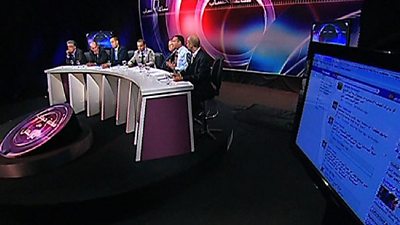Downloads
Publication date: September 2013
Sa’at Hissab was a series of debate programmes held across five Arab countries in which live studio audiences questioned a panel of leaders within and across countries. ����ý Media Action’s research and evaluation showed that the project improved the confidence and ability of journalists, editors, producers, directors and camera operators to produce more shows of this type. It also showed that the audience members had a strong desire to participate in this type of show in the future.
This research used a range of methods including self-completion surveys, in-depth interviews and focus group discussions to evaluate the impact of the project on the journalists, editors and producers who received training. In addition, the audience who attended the filming of the shows were asked for their views via pre- and post-show self-completion questionnaires.
“I think that we are lacking these kinds of shows, and I think that’s what we need, especially at these times where there are a lot of debates going on. I think it’s something that is really needed, that’s what people want; they want to voice their opinions.” - Training participant (director), Egypt
“[I decided to come today] to participate actively by asking the questions which we always hear on the lips of the ordinary people who are not politicians.” - Female Tunisian studio audience member
Research approach
This research used a range of methods including self-completion surveys, in-depth interviews and focus group discussions to evaluate the impact of the project on the journalists, editors and producers who received training. In addition, the audience who attended the filming of the shows were asked for their views via pre- and post-show self-completion questionnaires.
“I think that we are lacking these kinds of shows, and I think that’s what we need, especially at these times where there are a lot of debates going on. I think it’s something that is really needed, that’s what people want; they want to voice their opinions.” - Training participant (director), Egypt
“[I decided to come today] to participate actively by asking the questions which we always hear on the lips of the ordinary people who are not politicians.” - Female Tunisian studio audience member
Key findings
- More than 200 journalists, editors, producers, directors and camera operators were trained through the project. Overall, the training made the majority of participants more confident and better equipped to produce audience-participation programmes.
- Everybody involved in the Sa’at Hissab project – practitioners and audiences alike – reported that they wanted to increase the capacity of local broadcasters to produce programmes that provide the audience with the opportunity to express their opinions and engage in debate.
- The overwhelming majority of studio audience members – 90 per cent – reported that they would like to see more programmes like Sa’at Hissab on local channels within their country.
Project context
Since December 2010, the Arab world has undergone a series of huge political and social changes. These changes have arisen out of people’s demand for greater citizen participation; however this is not yet broadly reflected in TV programming across the region. Despite this background, there are a large number of well-qualified journalists and news providers who are keen to engage citizens’ voices, but are unfamiliar with the processes of working with a studio audience. This project trained media providers with the aim of enabling them to create an audience-led participatory debate programme independently and without ����ý assistance in the future.
Implications and impact
This project both developed capacity in partner stations and demonstrated a demand for audience-participation programming in the target countries. These two factors create the potential for an increase in the production of high quality, impartial audience-participation programmes in these countries without ����ý assistance in the future.
The training had a positive impact on practitioners’ capacity, with evidence of an increase in trainees’ skills in audience-participation programming in particular. However, the research also revealed that despite the positive impact of this project, there remains a need for ongoing training and a greater number of opportunities within partner stations for trainees to practice and implement their learning.
The audience in the target countries had a positive attitude towards programming that provides opportunities to express their opinions and engage in debate, and there is a clear demand for more programming of this type. The studio audience at the Sa’at Hissab recordings had a strong desire to participate and express their views through this medium.
“Let me tell you something about [the] audience – if you allow them to participate, they would enrich the programmes; we have a smart audience, very smart. They always raise intelligent questions, they present ideas very well. Even on major political issues, an average spectator would be well informed. This contemptuous approach to the … audience is wrong, they are very intelligent. There needs to be a more participatory approach ... The few examples where the audience were allowed to participate have proved to be good.” - Training participant (camera operator), Tunisia
